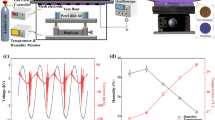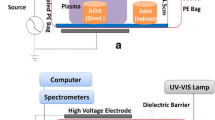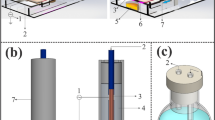Abstract
Cold plasma as a promising method to boost food safety and improve shelf life has triggered a huge amount of innovative scientific inquiry. The current study evaluates the effect of air plasma surface barrier discharge (SBD) treatment on the inactivation of Aspergillus niger spores for saffron stigma post packaging. The induced effects of the process on the physicochemical properties of the product are assessed. To identify the decontamination agents and plasma-produced reactive oxygen and nitrogen species, optical emission spectroscopy, ozone, and NOx measurements were used. The influence of plasma treatment on the surface morphology, antioxidant activity, color, flavor, odor, nitrate, and ammonium content of samples was determined by field emission scanning electron microscopy (FESEM), 2,2-diphenyl-1-picrylhydrazyl (DPPH), ultraviolet–visible spectrophotometry, colorimetry, high-performance liquid chromatography (HPLC), and ion chromatography (IC), respectively. The results showed that increased treatment time increased the germination period for Aspergillus niger conidia with spore growth ceasing after 2 min of plasma exposure. The antioxidant inhibition percentage of control and 2-min plasma-treated samples was 23.386 and 25.861, respectively. FESEM images showed this remote plasma treatment method did not etch the cell wall of saffron strands. The results of HPLC and IC analysis indicated that plasma treatment had no obvious effect on the main chemical compounds of saffron. The findings point to the potential of SBD plasma processing for packaged saffron with no detrimental effects on the vital components responsible for odor, flavor, color, antioxidant activity, and morphology. The SBD plasma offers a rapid and low-cost solution for saffron sanitization.
Graphical Abstract







Similar content being viewed by others
Data Availability
Data will be available on request.
References
Alves Filho, E. G., Silva, L. M. A., de Brito, E. S., Castro, D. R., Bezerra, J. A., Sanches, E. A., ... & Campelo, P. H. (2021). Effect of glow and dielectric barrier discharges plasma on volatile and non-volatile chemical profiling of camu-camu juice. Food and Bioprocess Technology, 14(7), 1275–1286.
Ambrico, P. F., Šimek, M., Rotolo, C., Morano, M., Minafra, A., Ambrico, M., ... & De Miccolis Angelini, R. M. (2020). Surface dielectric barrier discharge plasma: A suitable measure against fungal plant pathogens. Scientific Reports, 10(1), 3673.
Amini, M., Ghoranneviss, M., & Abdijadid, S. (2017). Effect of cold plasma on crocin esters and volatile compounds of saffron. Food Chemistry, 235, 290–293.
Ashtiani, S.-H.M., Rafiee, M., Morad, M. M., Khojastehpour, M., Khani, M. R., Rohani, A., Shokri, B., & Martynenko, A. (2020). Impact of gliding arc plasma pretreatment on drying efficiency and physicochemical properties of grape. Innovative Food Science & Emerging Technologies, 63, 102381.
Assimopoulou, A. N., Sinakos, Z., & Papageorgiou, V. (2005). Radical scavenging activity of Crocus sativus L. extract and its bioactive constituents. Phytotherapy Research: An International Journal Devoted to Pharmacological and Toxicological Evaluation of Natural Product Derivatives, 19(11), 997–1000.
Bennett, S. E. B. J. W. (2007). An overview of the genus Aspergillus. The Aspergilli, 23–34.
Braca, A., De Tommasi, N., Di Bari, L., Pizza, C., Politi, M., & Morelli, I. (2001). Antioxidant principles from bauhinia t arapotensis. Journal of Natural Products, 64(7), 892–895.
Bruno, G., Heusler, T., Lackmann, J. W., von Woedtke, T., Weltmann, K. D., & Wende, K. (2019). Cold physical plasma-induced oxidation of cysteine yields reactive sulfur species (RSS). Clinical Plasma Medicine, 14, 100083.
Camacho, J. J., Diaz, L., Santos, M., Juan, L. J., & Poyato, J. M. L. (2010). Time-resolved optical emission spectroscopy of laser-produced air plasma. Journal of Applied Physics, 107(8), 083306.
Cerdá-Bernad, D., Valero-Cases, E., Pastor, J. J., & Frutos, M. J. (2022). Saffron bioactives crocin, crocetin and safranal: Effect on oxidative stress and mechanisms of action. Critical Reviews in Food Science and Nutrition, 62(12), 3232–3249.
Charoux, C. M., Free, L., Hinds, L. M., Vijayaraghavan, R. K., Daniels, S., O’Donnell, C. P., & Tiwari, B. K. (2020). Effect of non-thermal plasma technology on microbial inactivation and total phenolic content of a model liquid food system and black pepper grains. Lwt, 118, 108716.
Dasan, B. G., Onal-Ulusoy, B., Pawlat, J., Diatczyk, J., Sen, Y., & Mutlu, M. (2017a). A new and simple approach for decontamination of food contact surfaces with gliding arc discharge atmospheric non-thermal plasma. Food and Bioprocess Technology, 10(4), 650–661.
Dasan, B. G., Boyaci, I. H., & Mutlu, M. (2017b). Nonthermal plasma treatment of Aspergillus spp. spores on hazelnuts in an atmospheric pressure fluidized bed plasma system: Impact of process parameters and surveillance of the residual viability of spores. Journal of Food Engineering, 196, 139–149.
Dasan, B. G., & Boyaci, I. H. (2018). Effect of cold atmospheric plasma on inactivation of Escherichia coli and physicochemical properties of apple, orange, tomato juices, and sour cherry nectar. Food and Bioprocess Technology, 11(2), 334–343.
De Geyter, N. (2013). Influence of dielectric barrier discharge atmosphere on polylactic acid (PLA) surface modification. Surface and Coatings Technology, 214, 69–76.
Dong, X. Y., & Yang, Y. L. (2019). A novel approach to enhance blueberry quality during storage using cold plasma at atmospheric air pressure. Food and Bioprocess Technology, 12(8), 1409–1421.
Fridman, A. (2008). Plasma chemistry. Cambridge University Press.
Garofulić, I. E., Jambrak, A. R., Milošević, S., Dragović-Uzelac, V., Zorić, Z., & Herceg, Z. (2015). The effect of gas phase plasma treatment on the anthocyanin and phenolic acid content of sour cherry Marasca (Prunus cerasus var. Marasca) juice. LWT-Food Science and Technology, 62(1), 894–900.
Hadizadeh, F., Mahdavi, M., Emami, S. A., Khashayarmanesh, Z., Hassanzadeh, M., Asili, J., Seifi, M., Nassirli, H., Shariatimoghadam, A., & Noorbakhsh, R. (2006). Evaluation of ISO method in saffron qualification. II International Symposium on Saffron Biology and Technology, 739, 405–410.
Heo, Y. S., Yim, D. G., Baek, K. H., Kang, T., Lee, Y. E., Kim, J., Choe, W., & Jo, C. (2021). Effect of inkjet-printed flexible dielectric barrier discharge plasma on reduction of pathogen and quality changes on sliced cheese. LWT, 143, 111128.
Hesseltine, C. W., Shotwell, O. L., Ellis, J. J., & Stubblefield, R. D. (1966). Aflatoxin formation by Aspergillus flavus. Bacteriological Reviews, 30(4), 795.
Hojnik, N., Modic, M., Ni, Y., Filipič, G., Cvelbar, U., & Walsh, J. L. (2019). Effective fungal spore inactivation with an environmentally friendly approach based on atmospheric pressure air plasma. Environmental Science & Technology, 53(4), 1893–1904.
Hosseini, S. I., Farrokhi, N., Shokri, K., Khani, M. R., & Shokri, B. (2018). Cold low pressure O2 plasma treatment of Crocus sativus: An efficient way to eliminate toxicogenic fungi with minor effect on molecular and cellular properties of saffron. Food Chemistry, 257(March), 310–315.
Kabiri, M., Rezadoost, H., & Ghassempour, A. (2017). A comparative quality study of saffron constituents through HPLC and HPTLC methods followed by isolation of crocins and picrocrocin. LWT, 84, 1–9.
Khazdair, M. R., Boskabady, M. H., Hosseini, M., Rezaee, R., & Tsatsakis, A. M. (2015). The effects of Crocus sativus (saffron) and its constituents on nervous system: A review. Avicenna Journal of Phytomedicine, 5(5), 376.
Kiani, S., Minaei, S., & Ghasemi-Varnamkhasti, M. (2018). Instrumental approaches and innovative systems for saffron quality assessment. Journal of Food Engineering, 216, 1–10.
Kim, J. E., Oh, Y. J., Won, M. Y., Lee, K.-S., & Min, S. C. (2017). Microbial decontamination of onion powder using microwave-powered cold plasma treatments. Food Microbiology, 62, 112–123.
Kogelheide, F., Kartaschew, K., Strack, M., Baldus, S., Metzler-Nolte, N., Havenith, M., ... & Lackmann, J. W. (2016). FTIR spectroscopy of cysteine as a ready-to-use method for the investigation of plasma-induced chemical modifications of macromolecules. Journal of Physics D: Applied Physics, 49(8), 084004.
Kogelschatz, U. (2003). Dielectric-barrier discharges: Their history, discharge physics, and industrial applications. Plasma Chemistry and Plasma Processing, 23(1), 1–46.
Kozlov, K. V., Wagner, H. E., Brandenburg, R., & Michel, P. (2001). Spatio-temporally resolved spectroscopic diagnostics of the barrier discharge in air at atmospheric pressure. Journal of Physics D: Applied Physics, 34(21), 3164.
Kronn, T. G., Lawrence, K. C., Zhuang, H., Hiett, K. L., Rothrock, M. J., Huang, Y. W., ... & Abdo, Z. (2015). Nonthermal plasma system for extending shelf life of raw broiler breast fillets. Transactions of the ASABE, 58(2), 493–500.
Lackmann, J. W., Baldus, S., Steinborn, E., Edengeiser, E., Kogelheide, F., Langklotz, S., ... & Bandow, J. E. (2015). A dielectric barrier discharge terminally inactivates RNase A by oxidizing sulfur-containing amino acids and breaking structural disulfide bonds. Journal of Physics D: Applied Physics, 48(49), 494003.
Lyu, J., Tegelaar, M., Post, H., Moran Torres, J., Torchia, C., Altelaar, A. M., ... & Wösten, H. A. (2023). Heterogeneity in spore aggregation and germination results in different sized, cooperative microcolonies in an Aspergillus niger culture. Mbio, e00870–22.
Machala, Z., Janda, M., Hensel, K., Jedlovský, I., Leštinská, L., Foltin, V., Martišovitš, V., & Morvova, M. (2007). Emission spectroscopy of atmospheric pressure plasmas for bio-medical and environmental applications. Journal of Molecular Spectroscopy, 243(2), 194–201.
Madrid, I. M., Xavier, M. O., Mattei, A. S., Fernandes, C. G., Guim, T. N., Santin, R., ... & Meireles, M. C. A. (2010). Role of melanin in the pathogenesis of cutaneous sporotrichosis. Microbes and infection, 12(2), 162–165
McNeil, N. M. R., McDonnell, C., Hambrook, M., & Back, T. G. (2015). Oxidation of disulfides to thiolsulfinates with hydrogen peroxide and a cyclic seleninate ester catalyst. Molecules, 20(6), 10748–10762.
Misra, N. N., Moiseev, T., Patil, S., Pankaj, S. K., Bourke, P., Mosnier, J. P., ... & Cullen, P. J. (2014). Cold plasma in modified atmospheres for post-harvest treatment of strawberries. Food and bioprocess technology, 7(10), 3045–3054.
Misra, N. N., Tiwari, B. K., Raghavarao, K., & Cullen, P. J. (2011). Nonthermal plasma inactivation of food-borne pathogens. Food Engineering Reviews, 3(3–4), 159–170.
Namjoo, M., Moradi, M., Dibagar, N., & Niakousari, M. (2022). Cold plasma pretreatment prior to ultrasound-assisted air drying of cumin seeds. Food and Bioprocess Technology, 15(9), 2065–2083.
Niknam, V., & Ebrahimzadeh, H. (2002). Phenolics content in Astragalus species. Pakistan Journal of Botany, 34(3), 283–289.
Niveditha, A., Pandiselvam, R., Prasath, V. A., Singh, S. K., Gul, K., & Kothakota, A. (2021). Application of cold plasma and ozone technology for decontamination of Escherichia coli in foods-A review. Food Control, 130, 108338.
Offerhaus, B., Kogelheide, F., Jalat, D., Bibinov, N., Schulze, J., Stapelmann, K., & Awakowicz, P. (2019). Determination of NO densities in a surface dielectric barrier discharge using optical emission spectroscopy. Journal of Applied Physics, 126(19), 193301.
Pankaj, S. K., Wan, Z., & Keener, K. M. (2018). Effects of cold plasma on food quality: A review. Foods, 7(1), 4.
Panngom, K., Lee, S. H., Park, D. H., Sim, G. B., Kim, Y. H., Uhm, H. S., ... & Choi, E. H. (2014). Non-thermal plasma treatment diminishes fungal viability and up-regulates resistance genes in a plant host. PloS one, 9(6), e99300.
Popović-Djordjević, J. B., Stanković, J. S. K., Mihailović, V., & Akram, M. (2021a). Biochemistry and metabolism. In C. M. Galanakis (Ed.), Saffron (pp. 1–40). Academic Press.
Reineke, K., & Mathys, A. (2020). Endospore inactivation by emerging technologies: A review of target structures and inactivation mechanisms. Annual Review of Food Science and Technology, 11, 255–274.
Popović-Djordjević, J. B., Kostić, A. Ž, & Kiralan, M. (2021b). Antioxidant activities of bioactive compounds and various extracts obtained from Saffron. In C. M. Galanakis (Ed.), Saffron (pp. 41–97). Academic Press.
Rodriguez-Ruiz, V., Barzegari, A., Zuluaga, M., Zunooni-Vahed, S., Rahbar-Saadat, Y., Letourneur, D., Gueguen, V., & Pavon-Djavid, G. (2016). Potential of aqueous extract of saffron (Crocus sativus L.) in blocking the oxidative stress by modulation of signal transduction in human vascular endothelial cells. Journal of Functional Foods, 26, 123–134.
Sakiyama, Y., Graves, D. B., Chang, H. W., Shimizu, T., & Morfill, G. E. (2012). Plasma chemistry model of surface microdischarge in humid air and dynamics of reactive neutral species. Journal of Physics D: Applied Physics, 45(42), 425201.
Shahi, T., Assadpour, E., & Jafari, S. M. (2016). Main chemical compounds and pharmacological activities of stigmas and tepals of ‘red gold’; saffron. Trends in Food Science & Technology, 58, 69–78.
Shi, H., Ileleji, K., Stroshine, R. L., Keener, K., & Jensen, J. L. (2017). Reduction of aflatoxin in corn by high voltage atmospheric cold plasma. Food and Bioprocess Technology, 10(6), 1042–1052.
Sifuentes-Nieves, I., Mendez-Montealvo, G., Flores-Silva, P. C., Nieto-Pérez, M., Neira-Velazquez, G., Rodriguez-Fernandez, O., Hernández-Hernández, E., & Velazquez, G. (2021). Dielectric barrier discharge and radio-frequency plasma effect on structural properties of starches with different amylose content. Innovative Food Science & Emerging Technologies, 68, 102630.
Sohbatzadeh, F., Shakerinasab, E., Hajizadeh Chenari, I., Soltani, H., Khajvand Salehan, M., Pourbagher, R., ... & Ghasemi, M. (2022). Influence of PTFE and glass dielectric barrier discharge on Crocus sativus L. filaments: Physicochemical properties, bactericidal effects, and simulation. Journal of Food Processing and Preservation, 46(7), e16654.
Tabibian, S. A., Labbafi, M., Askari, G. H., Rezaeinezhad, A. R., & Ghomi, H. (2020). Effect of gliding arc discharge plasma pretreatment on drying kinetic, energy consumption and physico-chemical properties of saffron (Crocus sativus L.). Journal of Food Engineering, 270, 109766.
Teertstra, W. R., Tegelaar, M., Dijksterhuis, J., Golovina, E. A., Ohm, R. A., & Wösten, H. A. (2017). Maturation of conidia on conidiophores of Aspergillus niger. Fungal Genetics and Biology, 98, 61–70.
Tolouie, H., Mohammadifar, M. A., Ghomi, H., Yaghoubi, A. S., & Hashemi, M. (2018). The impact of atmospheric cold plasma treatment on inactivation of lipase and lipoxygenase of wheat germs. Innovative Food Science & Emerging Technologies, 47, 346–352.
Valsecchi, I., Lai, J. I., Stephen-Victor, E., Pillé, A., Beaussart, A., Lo, V., ... & Latgé, J. P. (2019). Assembly and disassembly of Aspergillus fumigatus conidial rodlets. The Cell Surface, 5, 100023.
Vukić, M., Vujadinović, D., Ivanović, M., Gojković, V., & Grujić, R. (2018). Color change of orange and carrot juice blend treated by non-thermal atmospheric plasma. Journal of Food Processing and Preservation, 42(2), 1–7.
Walsh, J. L., Liu, D. X., Iza, F., Rong, M. Z., & Kong, M. G. (2010). Contrasting characteristics of sub-microsecond pulsed atmospheric air and atmospheric pressure helium–oxygen glow discharges. Journal of Physics D: Applied Physics, 43(3), 032001.
Wang, Q., Pal, R. K., Yen, H. W., Naik, S. P., Orzeszko, M. K., Mazzeo, A., & Salvi, D. (2022). Cold plasma from flexible and conformable paper-based electrodes for fresh produce sanitation: Evaluation of microbial inactivation and quality changes. Food Control, 137, 108915.
Wang, J., Zhuang, H., & Zhang, J. (2016). Inactivation of spoilage bacteria in package by dielectric barrier discharge atmospheric cold plasma—treatment time effects. Food and Bioprocess Technology, 9(10), 1648–1652.
Wang, R. X., Nian, W. F., Wu, H. Y., Feng, H. Q., Zhang, K., Zhang, J., Zhu, W. D., Becker, K. H., & Fang, J. (2012). Atmospheric-pressure cold plasma treatment of contaminated fresh fruit and vegetable slices: Inactivation and physiochemical properties evaluation. The European Physical Journal D, 66(10), 276.
Xu, L., Yepez, X., Applegate, B., Keener, K. M., Tao, B., & Garner, A. L. (2020). Penetration and microbial inactivation by high voltage atmospheric cold plasma in semi-solid material. Food and Bioprocess Technology, 13(10), 1688–1702.
Yong, H. I., Lee, H., Park, S., Park, J., Choe, W., Jung, S., & Jo, C. (2017). Flexible thin-layer plasma inactivation of bacteria and mold survival in beef jerky packing and its effects on the meat’s physicochemical properties. Meat Science, 123, 151–156.
Author information
Authors and Affiliations
Contributions
Seyed Iman Hosseini designed the experiments and conceptualized the work and Hamid Reza Samadlouie designed the microbial sections. Seyed Iman Hosseini, Elaheh Ebrahimi, and Babak Mohammadhosseini performed the experiments and Hamid Reza Samadlouie performed the microbiological tests. All the authors discussed the results. Elaheh Ebrahimi, Hamid Reza Samadlouie, and Babak Mohammadhosseini wrote the manuscript, and Seyed Iman Hosseini and Patrick J. Cullen revised and edited the manuscript.
Corresponding author
Ethics declarations
Conflict of Interest
The authors declare no competing interests.
Additional information
Publisher's Note
Springer Nature remains neutral with regard to jurisdictional claims in published maps and institutional affiliations.
Rights and permissions
Springer Nature or its licensor (e.g. a society or other partner) holds exclusive rights to this article under a publishing agreement with the author(s) or other rightsholder(s); author self-archiving of the accepted manuscript version of this article is solely governed by the terms of such publishing agreement and applicable law.
About this article
Cite this article
Ebrahimi, E., Hosseini, S.I., Samadlouie, H.R. et al. Surface Barrier Discharge Remote Plasma Inactivation of Aspergillus niger ATCC 10864 Spores for Packaged Crocus sativus. Food Bioprocess Technol 16, 2570–2581 (2023). https://doi.org/10.1007/s11947-023-03083-4
Received:
Accepted:
Published:
Issue Date:
DOI: https://doi.org/10.1007/s11947-023-03083-4




